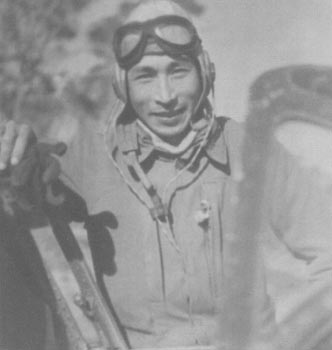Japan

First Lieutenant Hiroshi Sekiguchi
Japan

First Lieutenant Hiroshi Sekiguchi

Hiroshi Sekiguchi was born in 1914 in Saitama Prefecture and graduated from the Kawagoe Middle School.
He joined the 5th Flying Rentai on entering the Army in 1933, graduating as a pilot with the 58th NCO Cadet intake in July 1936.
After finishing fighter training at Akeno, he was posted back to the 5th Rentai.
He was transferred to the 1st chutai (the ‘Kato chutai’) of the 2nd Hiko Daitai (flight battalion) at the start of the Chinese Incident in July 1937 and moving with this unit to the northern China.
Up until 3 April 1938, this unit used the Kawasaki Ki-10 Type 95 ‘Perry’ biplane fighter.
During the afternoon on 25 October 1937, First Lieutenant Kosuke Kawahara’s flight from the 1st chutai of the 2nd Daitai (Ki-10s) flew as escort to First Lieutenant Mitsugu Sawada, who flew as a courier to Tsu-Chang with an unarmed aircraft. Over the front-line they met a Chinese Vought Corsair biplane, which was shot down by Kawahara.
In the evening, Sawada returned from Tsu-Chang and again they met a Corsair over the front-line, which was jointly shot down by Kawahara and Sergeant Major Sekiguchi.
Of the three Vought Corsairs of the 7th RG sent on a reconnaissance mission to Anyang, only one returned at 18:00. The other two (nos. 602 and 1205) were lost together with the four crew; Wang Kan and Han Shih-Yu and Ting Chia-Hsien and Wang Wen-Hsiu.
This was Sekiguchi’s first aerial engagement.
On 25 March 1938 the 1st chutai of the 2nd Daitai (Ki-10s), commanded by Captain Tateo Kato fought with Chinese I-152s over Guide. Although outnumbered 5 to 18 the Japanese pilots took a heavy tool of the Chinese aircraft. Captain Kato shot down four I-152s, Flight Sergeant Tanaka shot down two and Sergeant Major Sekiguchi shot down one.
First Lieutenant Kosuke Kawahara (leading the second element) was seen to shoot down two and pursue a third to the ground, when his aircraft was hit from behind and burst into flames. He waved to his wingman, Sekiguchi, before diving into the ground. First Lieutenant Mitsugu Sawada shared in the destruction of a large aircraft. Also in this combat was Tanaka forced to make an emergency landing and Sekiguchi was badly wounded in the thigh but managed to land and being transported to hospital.
The 2nd chutai of the 2nd Daitai also took part in this combat claiming 9 more victories, one of these being claimed by Yonesuke Fukuyama. Totally the 2nd Daitai’s 16 fighters claimed 19 victories for the loss of Kawahara.
According to Chinese records it seems that at least the 3rd PG took part in this combat. They lost six I-15bis and got three pilots killed when they where attacked by 19 Kawasaki Type 95 (Ki-10) biplane fighters of the 2nd Daitai near Kwei-teh airfield (Koi-toh in Japanese).
On return Kato could not believe that such a brilliant pilot as First Lieutenant Kawahara had been lost, and waited at the airfield until sunset in the hope of his late return. Next day as a sign of mourning, he shaved off a much beloved moustache.
During the Nomonhan Incident he served in Manchuria with the 1st chutai, 64th Sentai, from 20 August to 15 September 1939, claiming four victories during 20 plus sorties.
He returned to Japan in April 1941 and attended the Army Flying Military Academy, receiving his commission.
In November 1943 he was posted to the 68th Sentai, which had just re-equipped with Ki-61s, operating over New Guniea until February 1944, when he was involved in an accident as he and other pilots were being flown to Manila to collect replacement aircraft, and again he was hospitalised.
He returned to Japan in April 1944, subsequently joining the 105th Sentai, where he remained for the rest of the war.
Sakiguchi ended the war with 1 biplane victory and a total of 7.
Claims:
| Kill no. | Date | Time | Number | Type | Result | Plane type | Serial no. | Locality | Unit |
| 1937 | |||||||||
| 25/10/37 | p.m. | ½ | Corsair (a) | Shared destroyed | Ki-10 | Tsu-chang area | 2nd Hiko Daitai | ||
| 1938 | |||||||||
| 1 | 25/03/38 | 1 | I-152 (b) | Destroyed | Ki-10 | Guide area | 2nd Hiko Daitai | ||
| 1938 | |||||||||
| ? | ??/08-09/39 | 1 | Enemy aircraft | Destroyed | Ki-27 | Nomonhan | 64th Sentai | ||
| ? | ??/08-09/39 | 1 | Enemy aircraft | Destroyed | Ki-27 | Nomonhan | 64th Sentai | ||
| ? | ??/08-09/39 | 1 | Enemy aircraft | Destroyed | Ki-27 | Nomonhan | 64th Sentai | ||
| ? | ??/08-09/39 | 1 | Enemy aircraft | Destroyed | Ki-27 | Nomonhan | 64th Sentai |
Biplane victories: 1 and 1 shared destroyed.
TOTAL: 7 and 1 shared destroyed.
(a) Probably Vought Corsair from the 7th RG, which lost two aircraft (nos. 602 and 1205) during the day with their crews.
(b) In this combat the 2nd Daitai totally claimed 19 victories for the loss of 1st Lieutenant Kawahara.
Sources:
Esa mezivalecneho obdobi vol.3 - Tomas Polak, 1996 Plastic Kits Revue 45/96, Ostrava, Czech Republic kindly provided by Ondrej Repka.
Historie 64.sentaj vol.1 - Jaroslav Novotny Jr, 1993 Plastic Kits Revue 16/93, Ostrava, Czech Republic kindly provided by Ondrej Repka.
Japanese Army Air Force Aces 1937-45 - Henry Sakaida, 1997 Osprey Publishing, London, ISBN 1-85532-529-2
Japanese Army Air Force fighter units and their aces 1931-1945 - Ikuhiko Hata, Yasuho Izawa and Christopher Shores, 2002 Grub Street, London, ISBN 1-902304-89-6
Soviet Fighters in the sky of China, Part II - Anatolii Demin, 2000 Aviatsiia Kosmonavtika 10 (translated by George M. Mellinger)
Additional information kindly provided by Edward Chan.


